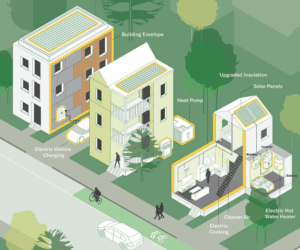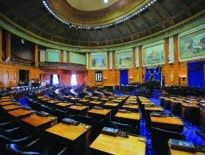Boston has fallen behind in addressing the climate crisis according to a new report that urges city leaders to expand electrification of small residential buildings and step up its coastal resiliency planning and funding agenda.
The Boston Foundation report, written by researchers at Northeastern University’s Dukakis Center for Urban and Regional Policy, said the city is unlikely to meet its own goal of achieving net-zero energy standards by 2050 without bolder policy decisions.
The report calls for retrofits to electrify heating and cooking systems for an estimated 70,000 small residential buildings that represent approximately half of Boston’s households. Many of the aging buildings, such as triple-deckers, rely on inefficient natural gas heating systems.
Conversions from gas to electric could create opportunities for growth of the green energy sector, including new jobs for economically underrepresented communities.
“This is a huge opportunity to scale equitably,” said Chris Cook, executive director of the Rose Kennedy Greenway, during a panel discussion on the report today. “Boston Harbor used to be filthy. Now it’s clean, and that has opened up a lot of opportunities. Every one of these big lifts that the report identifies creates big opportunities.”
Progress has been slow on installation of efficient building systems, with only 100 permits for heat pumps issued citywide in 2021 for residential buildings with three or fewer housing units. By contrast, more than 1,000 gas system replacement permits were issued.
Despite rebates and tax credits from the MassSave program and the Inflation Reduction Act, costs of retrofits are out of reach for many households. The Boston Green Ribbon Commission received a grant in 2021 from Bank of America to study the creation of a climate bank to finance building retrofits, a potential new funding source.
The state government should play a major role in the gas-to-electric transition through the establishment of a statewide industrial policy that establishes a timeline to decarbonize small building stock. The report urges the Department of Energy Resources to approve Boston’s application to ban fossil fuel systems in new buildings.
In September, Mayor Michelle Wu proposed requiring new buildings over 20,000 square feet be designed for net-zero carbon standards, through on-site renewable energy or renewable energy purchases from the power grid, or be assessed fines.
The report recommends additional city funding to pay for energy grid modernization. The Eversource energy grid in Charlestown, downtown and East Boston need to be upgraded to accommodate increased electricity demand and solar generation.
The report also raises questions about who will pay for multi-billion-dollar coastal resiliency projects to protect neighborhoods from flooding.
A planned $240-million resiliency project at South Boston’s Moakley Park, for instance, has received only $2.2 million in state and federal funding to date.
While American Rescue Plan Act (ARPA) and Inflation Reduction Act (IRA) funds are potential sources, the report urges the city to move beyond piecemeal funding policies. It recommends creation of a public governance agency, potentially on the state level, to coordinate and finance coastal resilience projects.
Boston officials have begun planning resiliency projects in the Seaport District, including a 2,090-foot-long sea wall on Fort Point Channel from 15 Necco St. to Dorchester Avenue, next to the Eli Lilly Co. research center under construction and the recently-approved Channelside development.
And in 2021, the Boston Planning & Development Agency began requiring developers of its properties in South Boston’s Raymond L. Flynn Marine Park to contribute to a fund that will pay for future resiliency projects.
But the report faults the city’s planning and permitting processes for largely failing to hold developers accountable for climate and resiliency planning. It spotlights the 600-acre Seaport District as a recent failure of developer-led planning. Resiliency and community benefit packages are made during negotiations with individual developers.
“As we see from the Seaport example, the Boston Planning and Development Agency hesitates to make big demands on developers (e.g., mandatory inclusionary housing onsite rather than paying into pool; investment in transit infrastructure; public green space) for fear of scaring them off and losing the associated tax base. Many of Boston’s developers are from out of town and don’t have a vested interest in community improvement beyond their project,” the report states.




 |
| 




